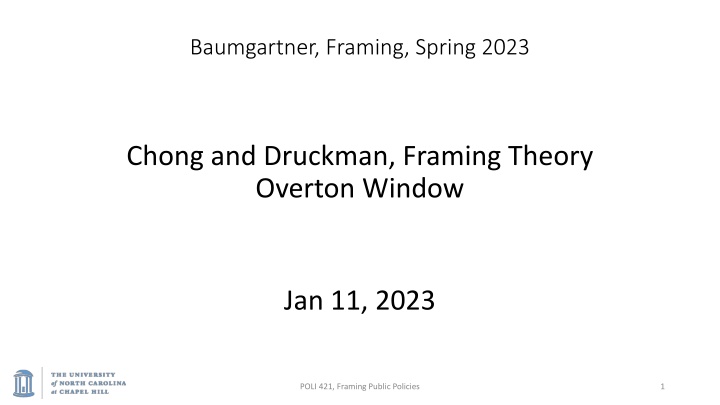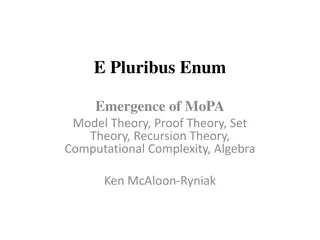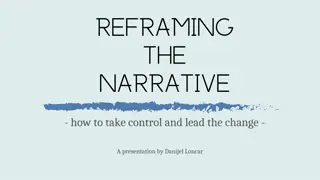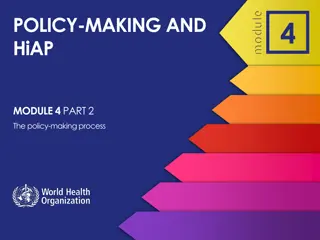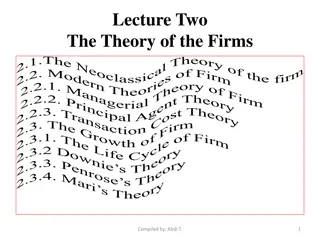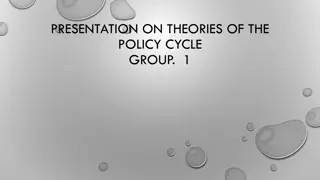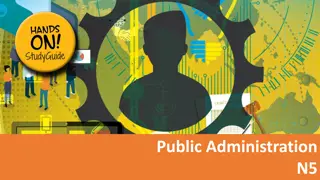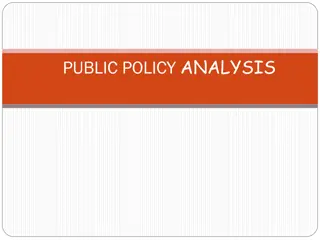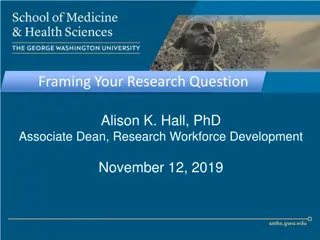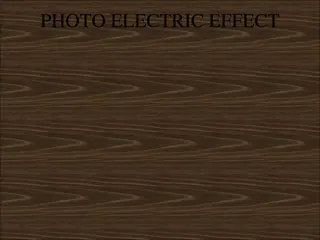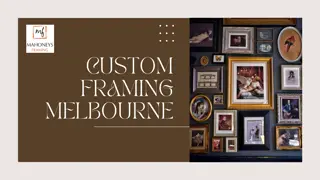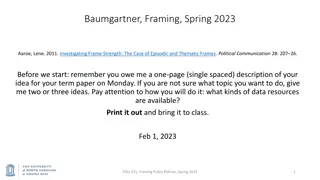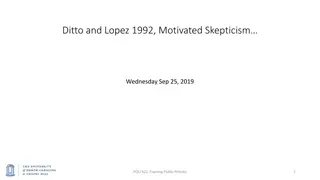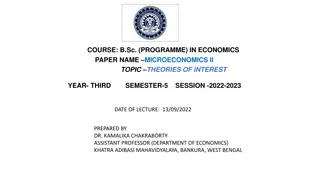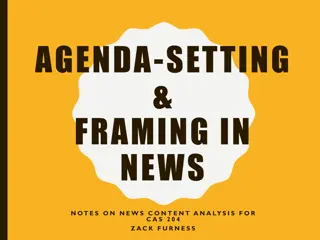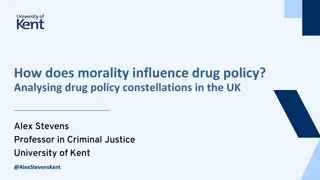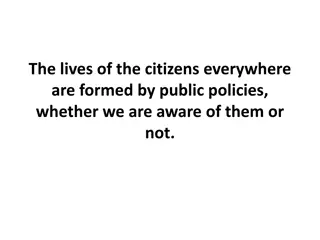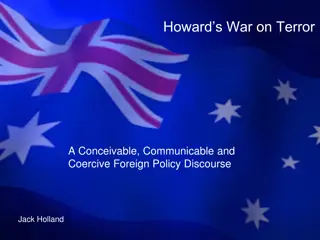Framing Theory in Public Policy Analysis
The provided text offers insights into framing theory within the context of public policy studies. It discusses key concepts such as the multiple perspectives through which issues can be viewed and the factors influencing framing effects. The content also touches on practical aspects like tackling overcrowding issues and delves into the process of developing term paper projects. Students are guided on exploring historical and contemporary cases, researching using resources like Nexis-Uni, and analyzing arguments and actors to form a comprehensive understanding of framing in public policies.
Download Presentation

Please find below an Image/Link to download the presentation.
The content on the website is provided AS IS for your information and personal use only. It may not be sold, licensed, or shared on other websites without obtaining consent from the author.If you encounter any issues during the download, it is possible that the publisher has removed the file from their server.
You are allowed to download the files provided on this website for personal or commercial use, subject to the condition that they are used lawfully. All files are the property of their respective owners.
The content on the website is provided AS IS for your information and personal use only. It may not be sold, licensed, or shared on other websites without obtaining consent from the author.
E N D
Presentation Transcript
Baumgartner, Framing, Spring 2023 Chong and Druckman, Framing Theory Overton Window Jan 11, 2023 POLI 421, Framing Public Policies 1
The overcrowding issue will be solved! We are working on a plan to find another room and to expand the enrollment limit for this class. We expect to have it solved tomorrow! We should also have a new, bigger, room next week. Watch your emails. Open enrollment is closed, so any new enrollments will be by permission and handled by Millie Tan of the Pol Sci Dept office; she ll always need your name, PID, and if you also need to drop another class. She ll get you enrolled quickly and it should all be fixed by next week. Her email: mtan56@email.unc.edu. Please do not encourage other people to sign up. Enough is enough! But we can go to 45, including any TAM students. POLI 421, Framing Public Policies 2
A word about term paper projects Let s start talking, in office hours or among yourselves, about your topics. Recall the idea of historical cases (e.g., Equal Rights Amendment, Women s Suffrage ) as well as more recent controversies. But it can be current: campus sexual assault; Confederate memorials, all those current things are fair game as well. Foreign examples are fine as well; does not have to be from the US. Nexis-Uni from the library web site, or New York Times historical, or other historical newspaper web sites available through the UNC library may be key resources. Step 1. Find stories on your topic using keywords for the topic. Step 2. Read a bunch of stories and pay attention to the arguments and actors. Step 3. Develop keywords associated with the pro- and the anti-movement actors. Step 4. Create a chronology using counts of such keywords. Step 5. I can help you with the quantitative parts. Step 6. You can also read through histories as well as these newspaper stories to develop your own chronology and history of the issue, and its opponents and proponents. See the template as well as the instructions on the class web site. POLI 421, Framing Public Policies 3
Chong and Druckman: the vocabulary (p. 104) The major premise of framing theory is that an issue can be viewed from a variety of perspectives and be construed as having implications for multiple values or considerations. Framing refers to the process by which people develop a particular conceptualization of an issue or reorient their thinking about an issue. POLI 421, Framing Public Policies 4
Two really important concepts Mediation Things that generate framing effects The idea must be available in your memory. The idea must be accessible the more accessible, the more likely you are to use the idea. So Priming: make the idea accessible to someone by mentioning it just before you pop the question you are really interested in. Moderation Things that moderate or limit framing effects Strong predispositions Lots of knowledge Credibility of the source, cultural resonance, competing frames from other sources POLI 421, Framing Public Policies 5
Two simple examples of priming and framing Given the importance of free speech, do you believe the KKK should be allowed to hold a rally in [your town]? Given the risk of violence, do you believe the KKK should be allowed to hold a rally in [your town]? Would you support spending more on welfare programs? Would you support spending more on programs that aid the poor? Framing effects: 85 to 45 percent support; 20 to 65 percent support POLI 421, Framing Public Policies 6
How frames work (p. 110) (Mediation) Do you have certain items in your short term memory? Availability: can you remember it? Accessibility: is it immediately available? Were you just thinking of it? Unconscious mechanisms Conscious thought: rational decision-making These accessibility things don t matter for conscious thought, but they can play a role similar to implicit bias. POLI 421, Framing Public Policies 7
Moderating effects Strong prior beliefs: these make you resistant Knowing a lot about the topic Caring a lot about the topic Not trusting the opposing messenger Being exposed to counter-arguments in the same time period POLI 421, Framing Public Policies 8
Confusing concepts Equivalency frames 20 % chance to gain a dollar, v. 80 % chance not to lose a dollar 97 % fat free, v. 3 % fat 95 % employment, v. 5 % unemployment Priming Make a certain idea accessible, then ask a question IAD test: show a picture of a black face, and it makes the respondent quicker to see a gun, for example. This is priming; manipulating accessibility. It s a form of framing. Persuasion Change the weights on the attributes, v. change the evaluation of them. Really, does it matter? The decision changes either way. But the literature on framing and persuasion have emphasized different mechanisms. POLI 421, Framing Public Policies 9
Summary File this article away for your term paper. Use it, refer to it, like an encyclopedia article, or a dictionary. It s a good reference point for language, vocabulary, distinctions in use of terms, and in bibliographic starting points to dig more deeply into various issues. POLI 421, Framing Public Policies 10
The philosophical problem for the study of public opinion Democracy is supposed (by some) to involve accurate reflection of public preferences by governments. But if public preferences are so fickle as to be affected by simple framing effects, then how can there be democracy? Question: what are the topics, for you personally, where it would make no difference whatsoever how the question was phrased, you d never change your response? (E.g., strong attitudes) What are areas where your attitudes are weak and you would perhaps be affected by how the question was phrased? POLI 421, Framing Public Policies 11
Many unanswered questions in the study of framing We don t actually know what makes a frame strong v. weak. Existing studies identify strong frames by noting that they have a big impact. But we don t actually know many basics: Why are some frames strong? What is the value of excessive repetition of the same message? (e.g., can you buy influence by repeating the message, as in advertising?) What about counter-frames by the other side? Cultural resonance, patriotism, the use of group identity, and so forth. POLI 421, Framing Public Policies 12
The Math Your attitude toward an object is the sum of your weighted evaluations of the different dimensions (attributes) of the object Attitude = v(i)* w(i) v = evaluation of the object on attribute (i) w = the salience weight of that attribute (these sum to 1.00) Buy a car? Pay attention to: cost, horse power, color, local dealership, brand name, and many other factors. But some count more than others. Go to college? Date someone? Decide among candidates in an election? In any complicated decision, you intuitively go through a process of evaluating lots of things, and weighting some more than others. POLI 421, Framing Public Policies 13
Change your mind or change your focus? It s easier to change someone else s decision by getting them to change the WEIGHTS they assign to the different attributes than to get them to change the values they place on those attributes. Let s say you re a car salesperson with a reluctant buyer. You might try to get them to focus on the fact that the car is immediately available, and does not have to be ordered, when in conversation the buyer had paid no attention to that question at all. You are trying to up-weight the dimension of availability. Framing: shift the weights; persuasion: shift the evaluations. Framing is easier, and they both lead to the same outcome! POLI 421, Framing Public Policies 14
This person buys Car # 1 Person 1 Car 1 Car2 Car3 Attributes Weight Value Score Value Score Value Score MPG 0.50 9 4.50 5 2.50 3 1.50 Price 0.30 3 0.90 5 1.50 9 2.70 local dealer 0.05 5 0.25 5 0.25 5 0.25 friends have one - 0 - 5 - 10 - stylish 0.15 3 0.45 5 0.75 7 1.05 etc. - - - etc. - - - Total 1.00 6.10 5.00 5.50 POLI 421, Framing Public Policies 15
This person buys Car # 3. Same values, just different weights for the attributes Person 2 Car 1 Car2 Car3 Attributes Weight Value Score Value Score Value Score MPG 0.05 9 0.45 5 0.25 3 0.15 Price - 3 - 5 - 9 - local dealer 0.25 5 1.25 5 1.25 5 1.25 friends have one 0.50 0 - 5 2.50 10 5.00 stylish 0.20 3 0.60 5 1.00 7 1.40 etc. - - - etc. - - - Total 1.00 2.30 5.00 7.80 POLI 421, Framing Public Policies 16
This person has not taste at all, weighs all the attributes equally; they buy Car #3. No Taste Car 1 Car2 Car3 Attributes Weight Value Score Value Score Value Score MPG 0.20 9 1.80 5 1.00 3 0.60 Price 0.20 3 0.60 5 1.00 9 1.80 local dealer 0.20 5 1.00 5 1.00 5 1.00 friends have one 0.20 0 - 5 1.00 10 2.00 stylish 0.20 3 0.60 5 1.00 7 1.40 etc. - - - etc. - - - Total 1.00 4.00 5.00 6.80 POLI 421, Framing Public Policies 17
No one does this The point of this is just to explain that rather than changing people s understanding of whether the car has a higher or lower MPG, which is a fixed attribute, people argue about how much to care about (e.g., weigh) that particular attribute. Because complex decisions have many attributes (dimensions), there is a lot of room for action here. Note that there are no correct answers; in weighing diverse attributes, it really is a matter of taste. POLI 421, Framing Public Policies 18
If I give you a picture with an object in the middle, what associations come to mind? This is an opinion-object. Note: some associations lead to support, some to opposition to the object. Carbon neutral secrecy, war, military Nuclear Power high-paid jobs highly contaminated waste POLI 421, Framing Public Policies 19
Green revolution chemical companies Pesticides no more hunger endangered species POLI 421, Framing Public Policies 20
Good stand on taxes Can't trust them Candidate X Good stand on foreign policy wrong part of the country POLI 421, Framing Public Policies 21
Some interesting elements about these associations A given object may stimulate any number of associations in your mind These associations may be completely different from each other: incommensurate trade-offs That is, you might think: good on the issue of trade, but bad on the issue of integrity or personal morals Trade-offs with incommensurate or non-comparable items. Buying a car: you like the performance, but it s the wrong color No right or wrong way to do that POLI 421, Framing Public Policies 22
So, this really changes a lot over time Does your opinion change if your focus changes? Let s say you are totally stable: You don t like liars You support restricting immigration You also have other policy preferences and associate a candidate with a wide mix of attributes. At Time1 you support a given candidate At Time2, after relative attention shifts to a different set of attributes, you no longer support that candidate Did you change your mind? (You did change your behavior.) POLI 421, Framing Public Policies 23
We like dissent, but not dissenters Everyone agrees (generally) with various freedom of speech statements. But when communists , flag burners , white nationalists , neo-Nazis or other radicals are the object, opinion might differ. Think back to the opinion-object idea. What s at the center of the circle, and what psychological / cognitive connections do you have with it? Dissent > American tradition > Freedom of speech > basic US values (maybe?) Dissenters > people you disagree with > rabble-rousers > trouble-makers > violence > crime> danger (maybe?) POLI 421, Framing Public Policies 24
Do we want to fight against poverty, but simultaneously not like the poor? A A C C Poverty The Poor B B D D POLI 421, Framing Public Policies 25
The point about frames and decisions By manipulating the salience of different attributes, opinions can change. But note you did not really change your opinion on that attribute, rather you simply changed how important you think that attribute is compared to other attributes. But your behavior or overall preference may well change POLI 421, Framing Public Policies 26
The Overton Window POLI 421, Framing Public Policies 27
Overtons basic idea (or pitch to philanthropists about why to support think tanks) What was considered unthinkable some time ago may now be policy. Marriage equality, smoking bans, etc. But also earlier policy shifts: no borders in Europe, a single EU currency, free trade between the US and Mexico. All those were equally radical. So, promoting an idea, giving it credibility, can have dramatic, but only long-term benefits To get the big pay-offs in terms of public policy change, you need to take ideas that seem crazy today and make them mainstream. POLI 421, Framing Public Policies 28
Overton was a libertarian, and they are all about framing things in terms of personal freedom as opposed to government control. (But the idea is general.) POLI 421, Framing Public Policies 29
Some examples cribbed from a quick internet search (apologies to the authors). POLI 421, Framing Public Policies 30
Whats the point, why do we care? Framing is about changing people s understandings of a policy. It can involve radical change, not just marginal, incremental changes. Overton did not explain how to do it. But the concept is useful because it reminds us that the consequences can be huge. POLI 421, Framing Public Policies 32
